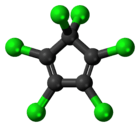Hexachlorocyclopentadiene
| |||
| Names | |||
|---|---|---|---|
| IUPAC name
1,2,3,4,5,5-hexachlorocyclopenta-1,3-diene | |||
| Other names
graphlox, perchlorocyclopentadiene | |||
| Identifiers | |||
| 77-47-4 | |||
| 3D model (Jmol) | Interactive image | ||
| ChemSpider | 6233 | ||
| ECHA InfoCard | 100.000.937 | ||
| PubChem | 6478 | ||
| |||
| |||
| Properties | |||
| C5Cl6 | |||
| Molar mass | 272.76 g·mol−1 | ||
| Appearance | Pale-yellow to amber-colored liquid | ||
| Odor | Pungent, unpleasant[1] | ||
| Density | 1.702 g/cm3 | ||
| Melting point | −10 °C (14 °F; 263 K) | ||
| Boiling point | 239 °C (462 °F; 512 K) | ||
| 0.0002% (Reacts, 25°C)[1] | |||
| Vapor pressure | 0.08 mmHg | ||
| Hazards | |||
| Main hazards | Teratogen | ||
| Flash point | 100 °C (212 °F; 373 K) | ||
| US health exposure limits (NIOSH): | |||
| PEL (Permissible) |
none[1] | ||
| REL (Recommended) |
TWA 0.01 ppm (0.1 mg/m3)[1] | ||
| IDLH (Immediate danger) |
N.D.[1] | ||
| Except where otherwise noted, data are given for materials in their standard state (at 25 °C [77 °F], 100 kPa). | |||
| | |||
| Infobox references | |||
Hexachlorocyclopentadiene, also known as C-56, is an organochlorine compound that is a precursor to several pesticides. This colourless liquid is an inexpensive reactive diene. Many of its derivatives proved to be highly controversial, as studies showed them to be persistent organic pollutants. Collectively, the pesticides derived from hexachlorocyclopentadiene are called the cyclodienes. An estimated 270,000 tons were produced until 1976, and some are still manufactured by Velsicol Chemical Corporation in the US and by Jiangsu Anpon Electrochemicals Co. in China. [2]
Synthesis and applications
Hexachlorocyclopentadiene is prepared by chlorination of cyclopentadiene to give 1,1,2,3,4,5-octachlorocyclopentane, which in a second step undergoes dehydrochlorination:[3]
- C5H6 + 6 Cl2 → C5H2Cl8 + 4 HCl
- C5H2Cl8 → C5Cl6 + 2 HCl
Hexachlorocyclopentadiene readily undergoes the Diels-Alder reaction to give a variety of adducts that were commercialized as pesticides. The main derivatives are:
- aldrin from norbornadiene (the related dieldrin is a metabolite of aldrin)
- bromodan from allyl bromide
- chlordane from cyclopentadiene, followed by chlorination
- endrin from acetylene, followed by cyclopentadiene, followed by epoxidation
- heptachlor from cyclopentadiene, followed by monochlorination
- isobenzan from dihydrofuran followed by chlorination
- endosulfan from 1,4-dihydroxy-2-butene, followed by esterification with SOCl2
Additionally hexachlorocyclopentadiene is the precursor to the pesticides mirex and kepone, although these are not classified as cyclodienes.
Regulation
Almost all derivatives have been banned or are under consideration for banning, according to the deliberations of the Stockholm Convention on Persistent Organic Pollutants.
Insect resistance
In addition to regulatory pressures, these pesticides became less effective owing to genetic mutations of the targeted insects. The number of insects resistant to cyclodienes and lindane approached 300 by 1989.[2]
References
- 1 2 3 4 5 "NIOSH Pocket Guide to Chemical Hazards #0315". National Institute for Occupational Safety and Health (NIOSH).
- 1 2 Robert L. Metcalf “Insect Control” in Ullmann’s Encyclopedia of Industrial Chemistry” Wiley-VCH, Wienheim, 2002. doi:10.1002/14356007.a14_263
- ↑ Dieter Hönicke, Ringo Födisch, Peter Claus, Michael Olson “Cyclopentadiene and Cyclopentene” Ullmann's Encyclopedia of Industrial Chemistry 2002, Wiley-VCH, Weinheim. doi:10.1002/14356007.a08_227

